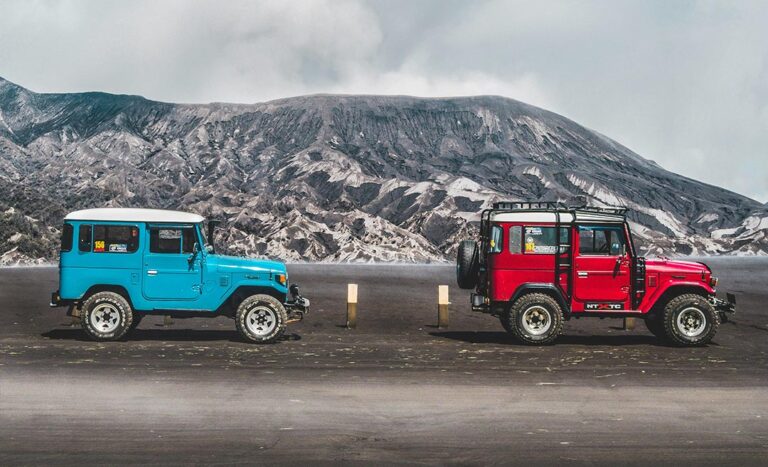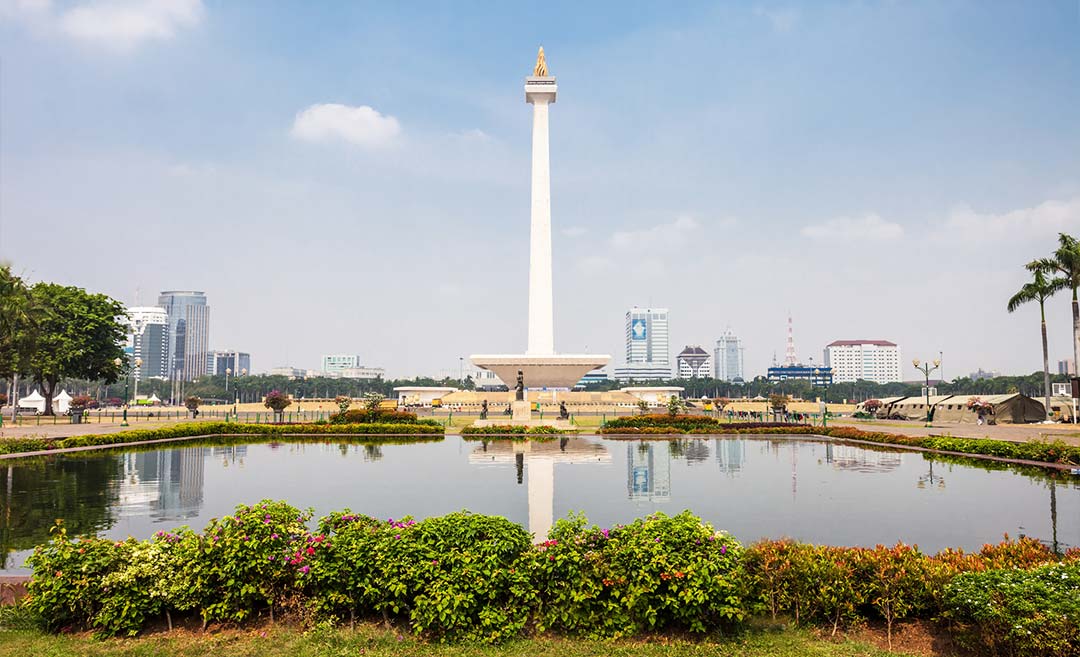Surabaya, the bustling capital of East Java, is Indonesia’s second-largest city. As one of the earliest trading ports in Southeast Asia, it is no surprise that this city is a cultural melting pot steeped in history.
In Indonesia, Surabaya is best known as ‘The City of Heroes’ for the Battle of Surabaya, an event that galvanised Indonesia’s independence movement in 1945.
But explore the city’s labyrinth of lanes, and you’ll see its storied past in everything, from its food and architecture to museums and ruins – some of which date back to the 13th-century Majapahit kingdom.
Here are some things to see and do in this captivating city:
Pay homage to heroes
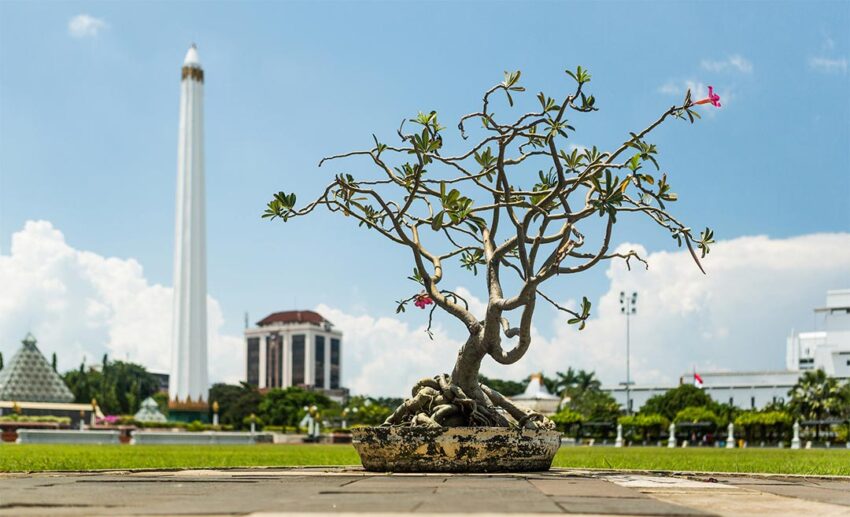
In Surabaya, there’s no shortage of landmarks that celebrate its people’s gallantry.
Start at the 41-metre tall Heroes Monument that commemorates the Battle of Surabaya, when Indonesian nationalists fought British troops who supported the Dutch attempt to recolonise the country.
Take a stroll along the lush lawns of Hotel Majapahit, one of the region’s iconic hotels and the site where Indonesian revolutionaries tore the blue bar from the Dutch flag, leaving only the red and white colours of the Indonesian flag.
Don’t skip the Governor Suryo Monument, dedicated to the first East Javanese governor who was killed while trying to quash the communist-led Madiun rebellion in 1948.
For a more legendary conflict, check out the Suro and Boyo Statue outside Surabaya Zoo, which depicts a battle between a shark and a crocodile. The city’s name is said to be derived from the suro (shark) and boyo (crocodile), and the two creatures are popular symbols of Surabaya.
Go museum-hopping
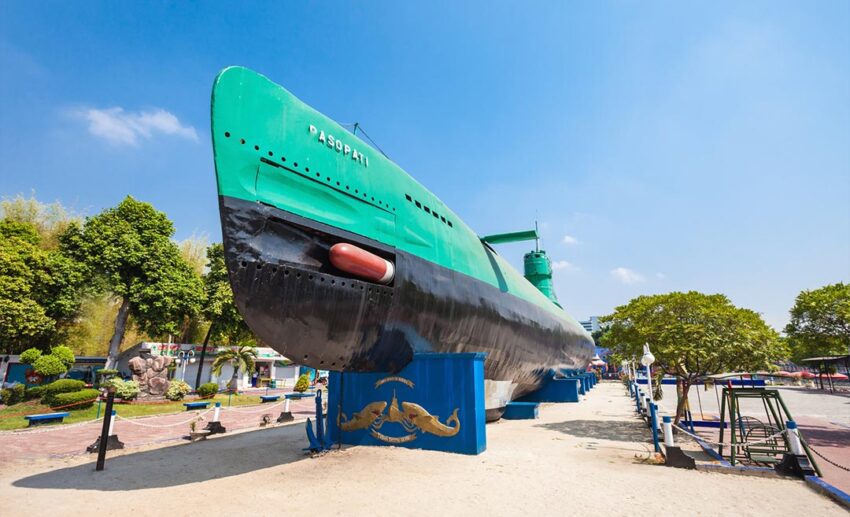
Trowulan Museum, located on the Trowulan archaeological site, houses the largest collection of relics from the ancient Majapahit Empire. Besides an extensive collection of terracotta figurines and pottery, the site is also home to the Candi Tikus bathing pool.
You can also visit the Bank Indonesia Museum, which is housed in a former De Javasche Bank building. This 1829 Renaissance Revival structure offers a peek into banking history, with artefacts ranging from antique banking machines to gold bars.
Military geeks can check out the Surabaya Submarine Monument, a decommissioned Russian submarine measuring 76.6 metres long and 6.3 metres wide. This immersive museum allows visitors to take a peek at control rooms and periscopes and learn about the ship’s naval history.
Museum Sepuluh November, located in the shadow of the Heroes Monument, is where you can learn more about the Battle of Surabaya through old photographs and documentary footage.
Admire unique religious sites
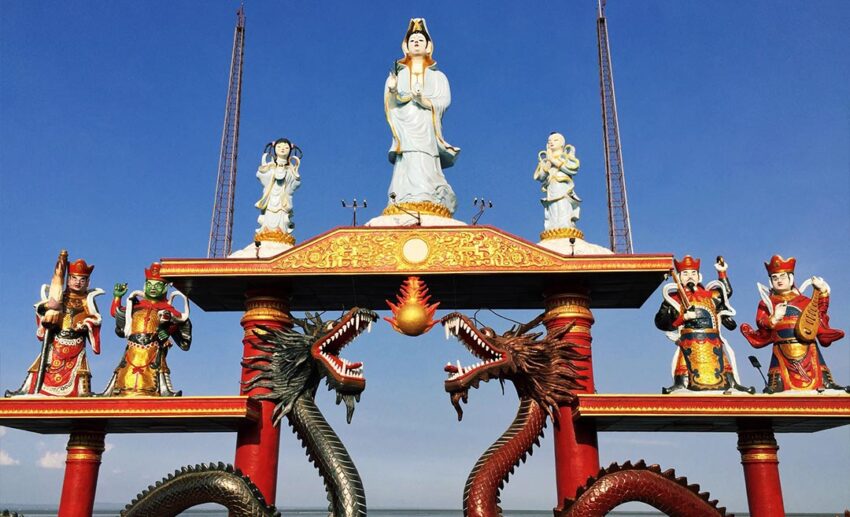
You’ll find a host of mosques, churches, and temples in Surabaya, but one of its most unique is Joko Dolog.
This image of Buddha Akshobhya is said to have originated from the Jawi temple in Malang or the Mojokerto Regency and was brought to Surabaya over 200 years ago. Crafted in 1289, the stone statue with Sanskrit inscriptions on its base was believed to be the embodiment of Kertanegara, the last ruler of the ancient Singhasari kingdom.
Then, there’s Sanggar Agung Temple, sitting on a bay overlooking the ocean. Occupying 4,000 square metres, it combines Javanese, Balinese, Chinese, and Thai architecture and is adorned with religious icons, including an 18-metre-tall Guan Yin statue and a Phra Phrom stupa.
Another landmark is the Cheng Hoo Mosque, named after celebrated Chinese-Muslim explorer Zheng He. Inspired by the architecture of Beijing’s Niujie Mosque, this vibrantly coloured place of worship with tiered, upturned tiled roofs is also adorned with Javanese and Arabic motifs.
Follow the Dutch heritage trail
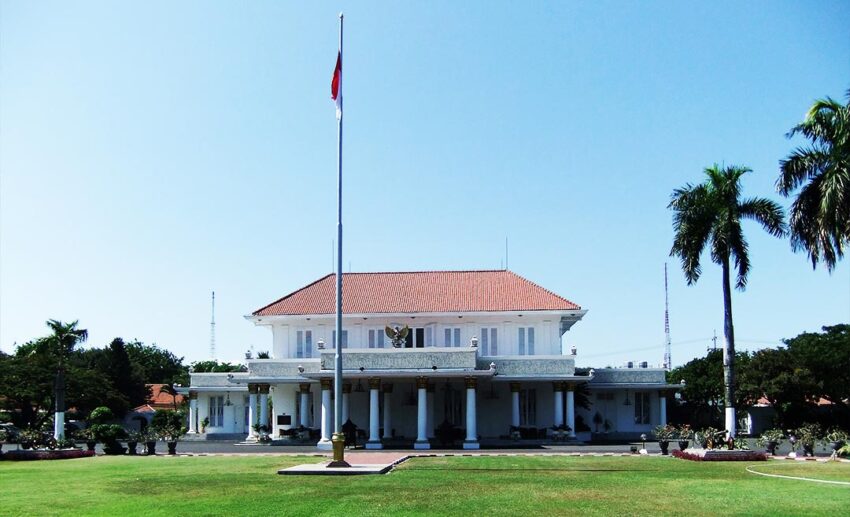
To explore Dutch colonial architecture, visit Surabaya’s old town. One of the most prominent structures is the Gedung Cerutu or Cigar Building, formerly a Dutch sugar trading office replete with gables and a distinctive cone-shaped dome.
Within the same area, you’ll also spot the eye-catching Art Deco style Gedung Maybank, built as Netherlands Spaarbank in 1914.
Another must-see is the Grahadi Building, the official residence of the East Java governor, constructed in 1795. Built by Dutch commissioner Dirk Van Hogendrop, this stately mansion overlooks a large lawn and has grand interiors constructed almost entirely from teak wood.
Walk along the 280-year-old Jembatan Merah, a bridge which witnessed some of the fiercest fighting in the Battle of Surabaya and remains an important symbol of Indonesia’s struggle for independence.
Visit the city’s cultural enclaves
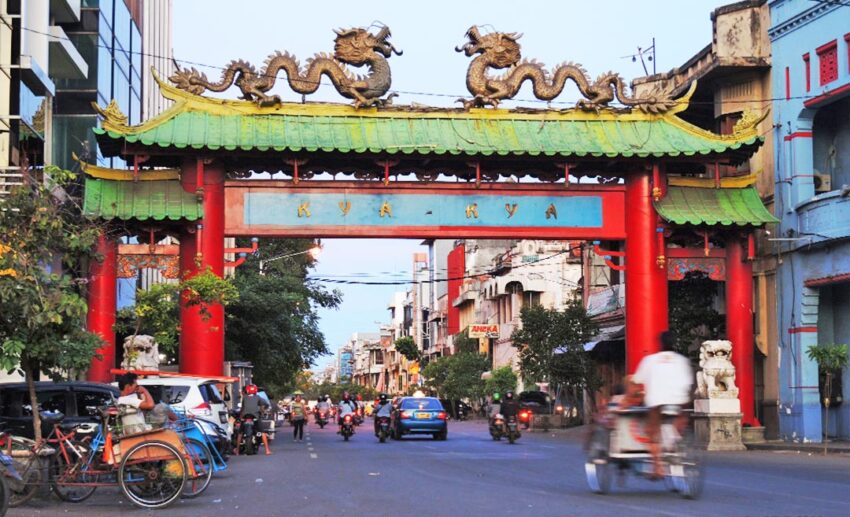
A bustling port during Dutch colonial times, Surabaya attracted hordes of settlers. In Ampel, the buzzing Arab quarter of the city, you’ll find a maze of shops selling everything from spices and perfumes to dates and lip-smacking street food.
There’s also Masjid Ampel, the oldest mosque in East Java, built in 1421 by Sunan Ampel, one of the nine Wali Songo saints of Islam revered in Java. The mosque, a showcase of Arab and Chinese architecture, also houses Sunan Ampel’s tomb.
Equally captivating is Chinatown, known locally as Kya-Kya Surabaya, home of the city’s early Chinese settlers. This area is popular for its bustling night markets and has recently been recast as a street food haven serving up sumptuous Chinese, Madurese, Javanese, and Arab eats.
While there, explore the historic Kong Co Kong Tik Cun Ong temple, which dates back to 1906. The temple, a Buddhist complex with Confucian and Taoist elements, was built for Hokkien settlers from Fujian.
Tuck into delectable street eats
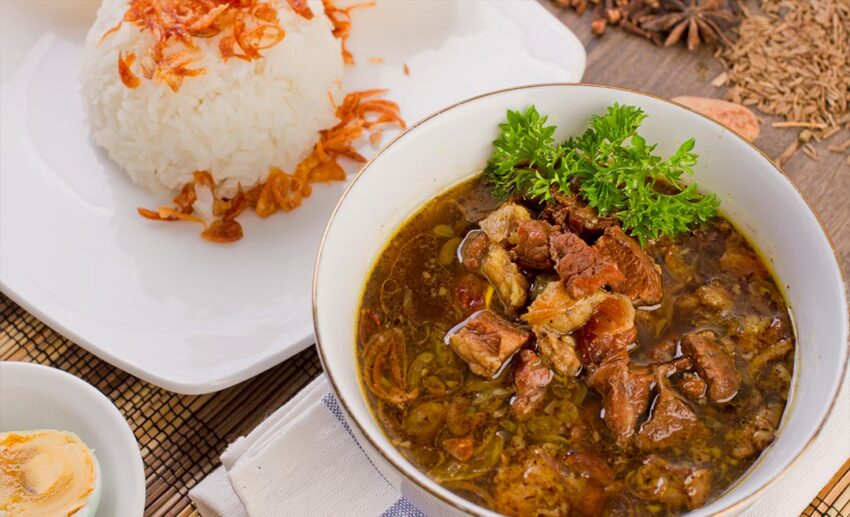
Save space in your belly for Surabayan treats from markets all around the city. For some of the most authentic local eats, look no further than Blauran Market.
Wolf down bowls of the smooth, coconut-ty pudding called bubur sum sum and lontong balap – rice cakes doused in sweet soya sauce and topped with beansprouts, fried shallots, and fiery sambal petis (chilli and seafood paste).
Feast on rujak cingur, a vegetable salad topped with sliced beef snout, rice cakes and the quintessentially Javanese tempeh doused with a rich, savoury sauce.
In Ampel Market, dive into Middle Eastern delicacies like lamb stew and kebabs and regional delights, including succulent satay and Nasi Madura, an assortment of fish, beef, shellfish, and sambal on a bed of rice.
The one dish you can’t miss in Surabaya is rawon, a dark, rich offering of slow-braised beef, cooked with aromatics and the main ingredient – earthy, pungent buah keluak.
Chill out with good brews and views
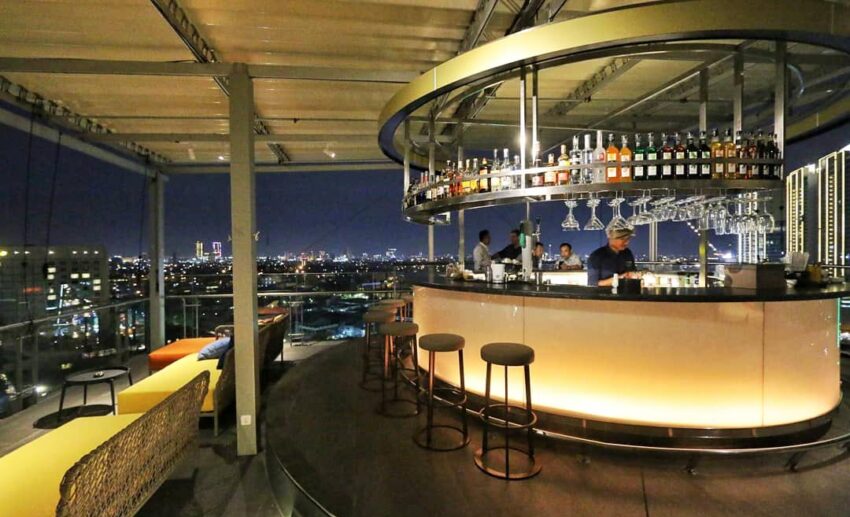
As can be expected, Indonesia’s second-largest city abounds with rooftop spaces.
Topping the list are cafes like the spacious Gusto Coffee, where you can get your caffeine fix while watching the sunset from its chic, al fresco rooftop spot, and Sky 36 Restaurant, which offers sweeping views of the city.
Fancy a tipple? Head up to the 21st floor of Java Paragon Hotel and Residences to the Citilites Sky Club & Bistro, or check out the sleek, swanky LAPPA Rooftop Bar and Lounge.
If you have cash to splash, Cloud 22 – DoubleTree by Hilton’s chic, contemporary setup with an exhaustive list of spirits and killer cocktails – comes highly recommended.
Explore family-friendly attractions
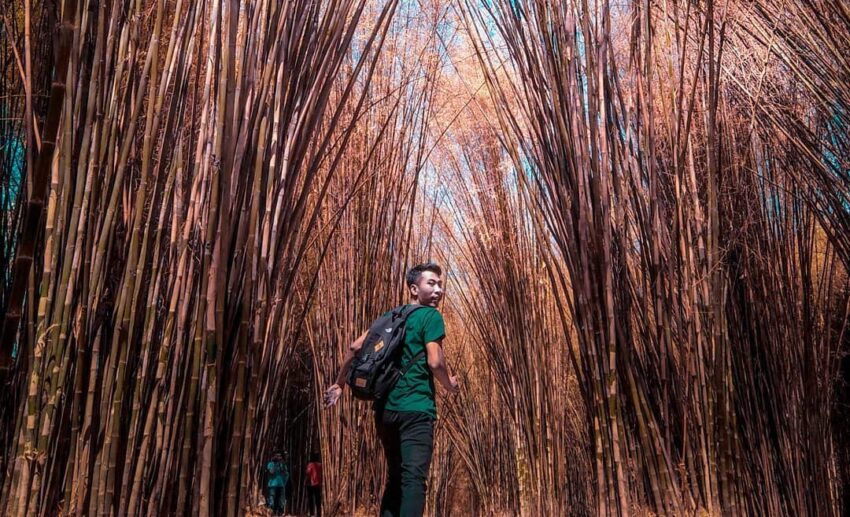
For a fun day with the fambam, head to Kenjeran Lama Beach. Here, you can picnic along the beach or enjoy grilled seafood from the many stalls that line its rustic, tree-lined gazebo area.
You can also spend a languid afternoon at the picturesque Keputih Bamboo Forest, a verdant 3.5-hectare oasis filled with bamboo trees lining meandering walkways, bamboo structures, and small ponds.
At sundown, head to the Kenjeran Dancing Fountain Park, a lush, green park where you can catch an exhilarating light and sound show at its main feature – a huge water fountain.
The park is also a great spot for breathtaking views of the Suramadu Bridge, one of Southeast Asia’s longest cable-style bridges, which spans 5.4 kilometres and links Surabaya with Madura Island.
Venture out to see an Indonesian icon
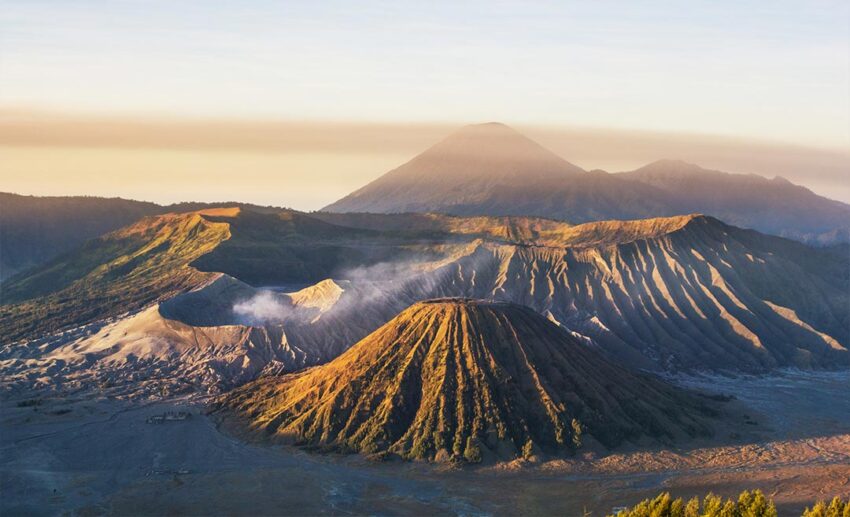
A stay in Surabaya isn’t complete without a visit to Mount Bromo, one of Indonesia’s most beautiful natural wonders, less than a three-hour drive from the city.
This active volcano rises 2,329 metres from the depths of a giant, arid caldera, sharing the space with four other equally jaw-dropping volcanoes.
Most adventure-seekers visit this sprawling caldera nestled within the Bromo Tengger Semeru National Park to hike the volcano’s crater, take jeep tours, or ride horses.
Tours usually start before daybreak, just in time to see the rugged cliffs and billowing smoke of the crater bathed in the glow of sunrise.
This story by Kerry-Ann Augustin was originally published on AirAsia. Zafigo republished this story in full with permission from the publisher, simply because good stories should be read by as many people as possible! If you have stories that will be of interest and useful to women travellers, especially in Asia, please get in touch with us at [email protected].
